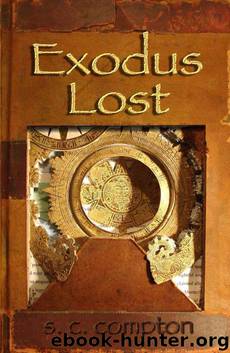Exodus Lost by S. C. Compton

Author:S. C. Compton [Compton, S. C.]
Language: eng
Format: epub
Published: 2010-11-24T05:00:00+00:00
Figure 33. La Venta, Altar Five, one of several massive Olmec thrones whose central theme is the king holding a sacrificed baby, apparently his own. The guides say that the king is crying. (Photo by author)
We have already seen that the foundational beliefs and mythologies of the Olmecs parallel in remarkable detail those of the ancient Near East. Perhaps the rain god and sacrifices did not originate in Olman but were part of a religion adopted from a drier region. Among the Canaanites, who lived in a far more arid region, the chief deity was the storm or rain god, best known as Baal. The Hyksos assimilated the attributes of Baal with the Egyptian god Set and made him their primary deity. Perhaps the Olmecs simply perpetuated this older desert religion and rain god despite their much wetter surroundings.
GEHENNA
The sight of babies burning alive as religious offerings in Ge Hinnom, “the valley of Hinnom” to the southwest of Jerusalem, gave the name to an early Jewish conception of a fiery underworld for the souls of the wicked. In the Greek of the New Testament this became Gehenna, a term that Jesus used for hell,472 and in the Arabic of the Qur’an it became the fiery underworld Jahannam.
This unspeakable ritual – so horrific that it gave name to our darkest notions of damnation – is best known from the Phoenician city of Carthage on the coast of what is now Tunisia in North Africa. Here archaeologists have excavated 20,000 urns containing the charred bones of sacrificed babies. Mesoamerica contains a similar site: “In Coxcatlan, in the Tehuacán Valley, a thousand urns were found, each containing the charred remains of children who had not died natural deaths.”473
CHILD OF THE KING
That a god would sacrifice his own son in this way parallels the Olmec thrones in which the king offers his own child. Such self-sacrifice by a ruler on behalf of his people has a long history in Mesoamerica. Mayan royalty commissioned elaborate reliefs advertising their sacrificial acts of bloodletting on behalf of their people, and the many Olmec images of the king with his sacrificed baby seem to have served a similar purpose. The king announces the magnitude of his sacrifice for his people. By comparison, anything he asked of them in terms of labor or taxation would seem a small request. And if he sent their children to war, well, he had already offered his own child for the greater good.
Download
This site does not store any files on its server. We only index and link to content provided by other sites. Please contact the content providers to delete copyright contents if any and email us, we'll remove relevant links or contents immediately.
The Vikings: Conquering England, France, and Ireland by Wernick Robert(79849)
Ali Pasha, Lion of Ioannina by Eugenia Russell & Eugenia Russell(40112)
The Conquerors (The Winning of America Series Book 3) by Eckert Allan W(37096)
The Vikings: Discoverers of a New World by Wernick Robert(36903)
Cecilia; Or, Memoirs of an Heiress — Volume 1 by Fanny Burney(32396)
Cecilia; Or, Memoirs of an Heiress — Volume 3 by Fanny Burney(31791)
Cecilia; Or, Memoirs of an Heiress — Volume 2 by Fanny Burney(31763)
Empire of the Sikhs by Patwant Singh(22934)
The Secret History by Donna Tartt(18794)
Hans Sturm: A Soldier's Odyssey on the Eastern Front by Gordon Williamson(18448)
Cat's cradle by Kurt Vonnegut(15130)
Pimp by Iceberg Slim(14279)
Sapiens: A Brief History of Humankind by Yuval Noah Harari(14192)
Talking to Strangers by Malcolm Gladwell(13167)
Norse Mythology by Gaiman Neil(13160)
Leonardo da Vinci by Walter Isaacson(13132)
4 3 2 1: A Novel by Paul Auster(12247)
Underground: A Human History of the Worlds Beneath Our Feet by Will Hunt(11992)
The Radium Girls by Kate Moore(11888)
